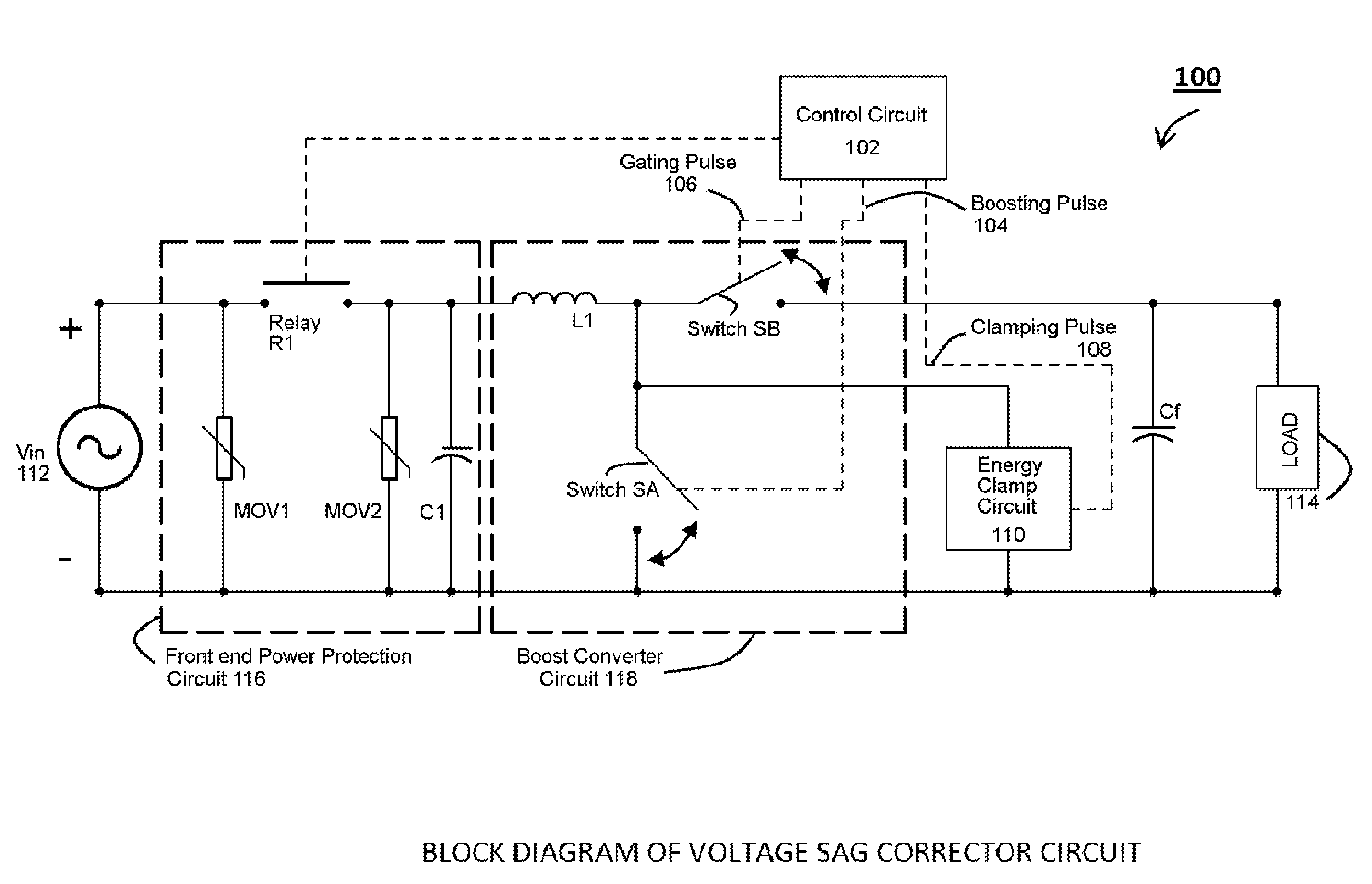Voltage Sag Corrector Using a Variable Duty Cycle Boost Converter
a technology of voltage sag correction and converter, which is applied in the direction of power conversion systems, dc-dc conversion, instruments, etc., can solve the problems of voltage sag, voltage sag, voltage sag, etc., and achieve the effect of reducing the number of voltage sags
- Summary
- Abstract
- Description
- Claims
- Application Information
AI Technical Summary
Benefits of technology
Problems solved by technology
Method used
Image
Examples
embodiment 100
[0026]Referring now to the figures, FIG. 1 illustrates a block diagram of an embodiment 100 of an exemplary sag corrector circuit. As shown, the disclosed sag corrector circuit connects the input AC line voltage (Vin) 112 to the load 114. In the embodiment shown, the sag corrector circuit comprises a front end power protection circuit 116, a boost converter circuit 118, an energy clamp circuit 110, a control circuit 102, and a filter capacitor Cf connected across the load.
[0027]Typically, the front end power protection circuit 116 includes non-linear circuit components such as varistors and other circuit components (e.g., relays etc.) for responding to power line disturbances such as over-voltages, sags, etc. According to one aspect, the front end power protection circuit 116 includes a MOV 1 with a higher voltage rating, a MOV2 with a lower voltage rating, and a relay R1 coupled between the two MOVs.
[0028]Coupled to the front end protection circuit 116 is a boost converter circuit ...
embodiment 300
[0046]Now turning to FIG. 3, an embodiment 300 of a sag corrector circuit is shown. As shown, the disclosed sag corrector circuit connects the AC line voltage (Vin) 112 to the load 114. In the embodiment shown, the sag corrector circuit comprises a front end power protection circuit 116, a boost converter circuit 118, an energy clamp circuit 110, a capacitor Cf connected across the load 114, and a control circuit 102 (for controlling the operation of the power protection circuit 116 and the boost converter circuit 118 via control signals or pulses).
[0047]Typically, the front end power protection circuit 116 includes non-linear circuit components such as varistors and other circuit components for responding to power line disturbances such as over-voltages, sags, etc. According to one aspect, the front end power protection circuit 116 includes a MOV 1 with a higher voltage rating, a MOV2 with a lower voltage rating, and a relay R1 coupled between the two MOVs. In one aspect, the relay...
PUM
 Login to View More
Login to View More Abstract
Description
Claims
Application Information
 Login to View More
Login to View More - R&D
- Intellectual Property
- Life Sciences
- Materials
- Tech Scout
- Unparalleled Data Quality
- Higher Quality Content
- 60% Fewer Hallucinations
Browse by: Latest US Patents, China's latest patents, Technical Efficacy Thesaurus, Application Domain, Technology Topic, Popular Technical Reports.
© 2025 PatSnap. All rights reserved.Legal|Privacy policy|Modern Slavery Act Transparency Statement|Sitemap|About US| Contact US: help@patsnap.com



